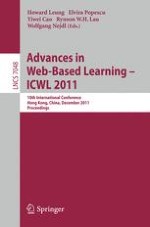This book constitutes the refereed proceedings of the 10th International Conference on Web-Based Learning, ICWL 2011, held in Hong Kong, China, in December 2011. The 27 revised full papers presented together with 9 short papers were carefully reviewed and selected from about 100 submissions. The papers report on research results or novel applications in web-based learning and address issues such as technology enhanced learning, personalized and adaptive learning, computer support for intelligent tutoring, intelligent tools for visual learning, Web-based learning for oriental languages learning, game-based learning, personal learning environments, computer supported collaborative learning, Web 2.0 and social learning environments, intelligent learner and group modeling, human factors and affective computing for learning, e-learning platforms and tools, design, model and framework of e-learning systems, deployment, organization and management of learning objects, e-learning metadata and standards, semantic Web and ontologies for e-learning, mobile, situated and blended learning, pedagogical issues, as well as practice and experience sharing.
